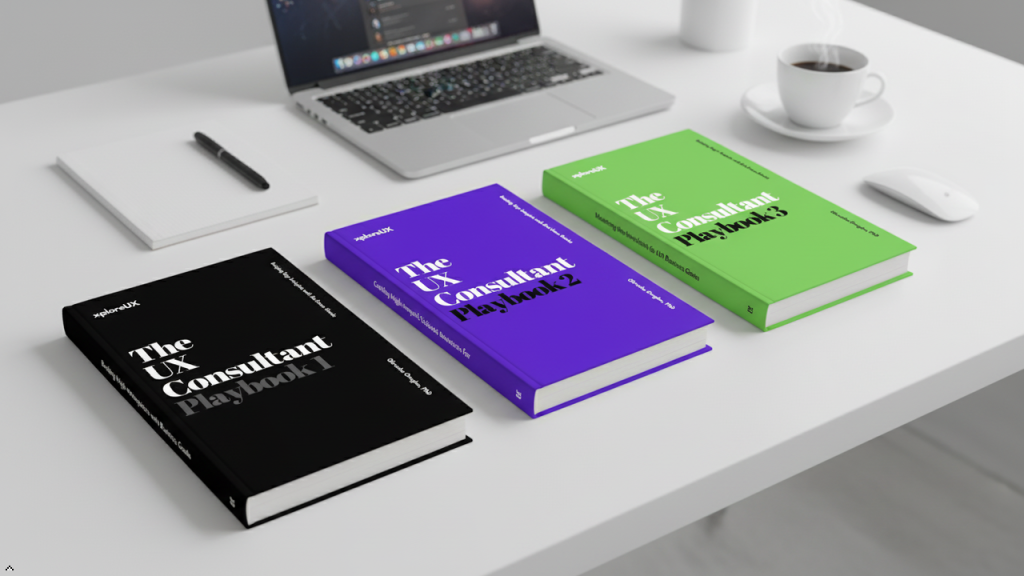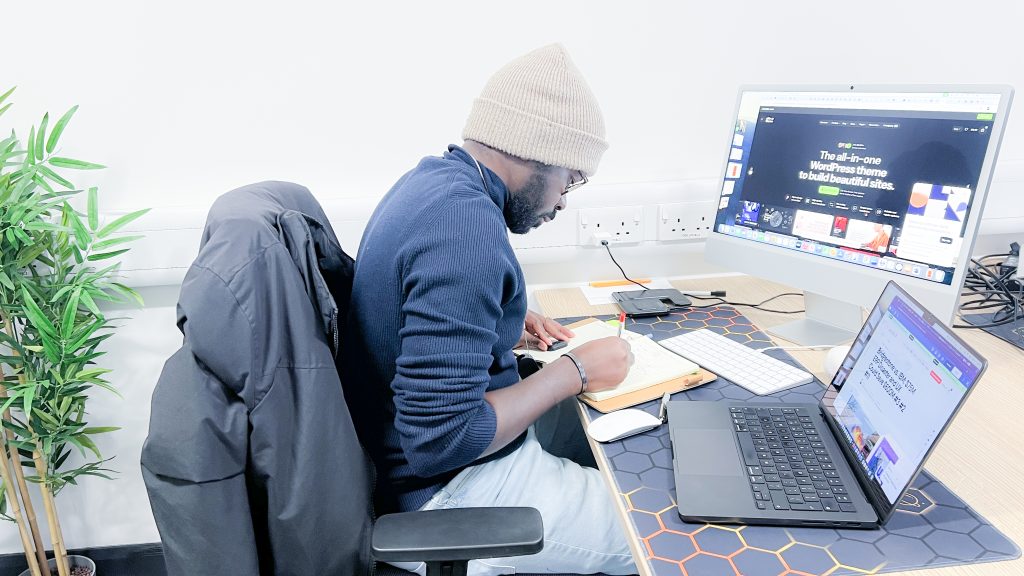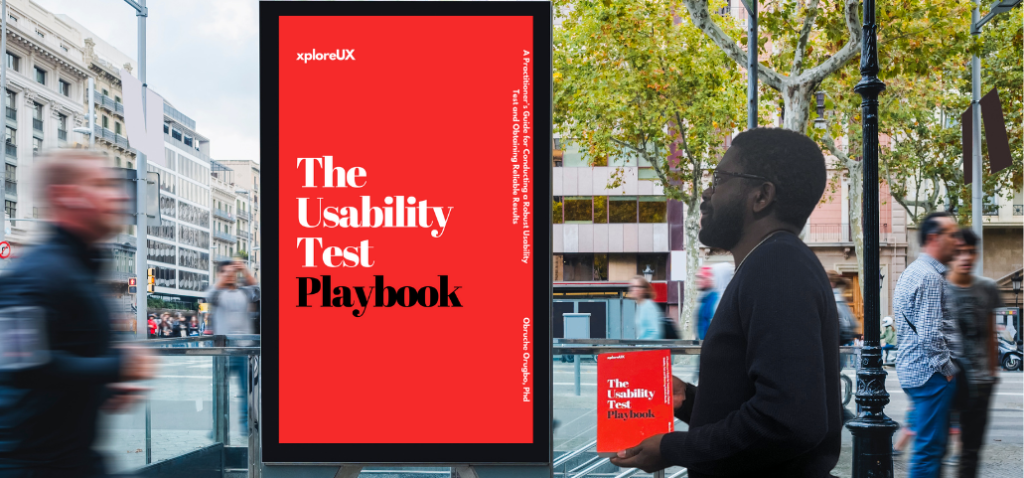
Ever wonder if fancy robots can replace UX researchers? The truth is, AI is a powerful tool, but it can’t capture the magic touch that humans bring. Here’s why: AI can crunch numbers and analyse data, but it can’t feel what users feel. It can’t see the little things – a furrowed brow, a frustrated sigh – that tell us a user’s having trouble.
AI is great at following instructions, but it can’t think outside the box and dream up surprising solutions. In short, AI can’t build relationships, ask the right questions on the fly, or tell a winning story with user research findings.
That’s where human researchers come in – the ones who listen, adapt, and translate user needs into real-world improvements.

Empathy is the magic ingredient that AI simply can’t replicate in UX research. It allows researchers to go beyond what users say and truly understand how they feel. Imagine you’re testing a new fitness app. An AI might analyse how many taps it takes users to complete a workout, but a UX researcher can observe a user struggling and frustrated. They can ask questions and listen to the user’s voice tremble as they talk about feeling discouraged.
This emotional connection helps the researcher understand that the app’s complexity might be a barrier, not just the number of steps. AI can’t pick up on these subtle cues. It can’t feel the user’s frustration or translate it into actionable insights.
A UX researcher, however, can use that empathy to identify pain points and design solutions that not only make the app easier to use but also feel more supportive and encouraging. In short, AI can tell you what users do, but a UX researcher with empathy can tell you why they do it and how to make it better for them emotionally as well as functionally. That’s the power of human connection in user experience research.

Imagine you’re designing a new fitness app. AI can analyse user data and tell you which features get the most clicks. But what it can’t do is understand the “why” behind those clicks. Here’s where context becomes crucial in UX research.
Let’s say the data shows high usage of the “workout history” feature. AI might interpret this as a sign users love it. But a UX researcher would dig deeper. They might observe users struggling to remember work out details and fumbling through the app to find them. This “high usage” could be out of frustration, not satisfaction.
Context goes beyond the app itself. A researcher might talk to users in their homes, observing their routines and fitness environments. They might discover limited gym access or forgetfulness after evening workouts. This context paints a whole new picture. The “workout history” feature isn’t a loved feature, it’s a coping mechanism.
By understanding context, the UX researcher can brainstorm solutions that truly address user needs. Maybe a quick log feature after each workout or integrating with wearable devices. AI can’t bridge this gap between data and the real world. It can’t see the cluttered home gym or the frustrated user flipping through screens. That’s the power of human observation and empathy in UX research – uncovering the true reasons behind user behaviour.

While AI excels at analysing data and identifying patterns, it lacks the spark of true creativity that’s crucial for effective UX research. Imagine you’re designing a new fitness app. AI can tell you which features users interact with most, but it can’t come up with the innovative gamification element that turns a chore into a fun challenge. Here’s where the human touch takes centre stage.
A UX researcher can act as a bridge between user insights and ground-breaking ideas. By talking to users, they understand the frustrations and desires that lie beneath the data. They can then use this knowledge to brainstorm unique solutions that truly address user needs.
Think of it like this: AI gives you the pieces of a puzzle, but a UX researcher is the one who can creatively assemble them into a stunning picture. They might combine seemingly unrelated user pain points to come up with a completely new feature that revolutionizes the user experience. They can even draw inspiration from unexpected sources, like children’s games or everyday tools, to find innovative ways to engage users.
This creative spark isn’t just about coming up with flashy features. It’s also about finding elegant solutions to complex problems. A UX researcher can think outside the box and develop intuitive interfaces that feel natural and effortless to use. They can craft user journeys that are not just functional, but also delightful and engaging.
In the ever-evolving world of technology, truly innovative design is what sets successful products apart. While AI is a powerful tool for UX research, it can’t replace the human ability to think creatively and come up with solutions that make a real difference in users’ lives.

Imagine having a conversation with a chatbot that seems to understand your initial questions. It analyses your keywords and throws back relevant information, but the conversation never truly progresses. That’s the limitation of AI in UX research – it can follow a script, but it can’t delve deeper.
The magic of user research lies in the unexpected. A user might mention a minor detail during an interview, something seemingly insignificant. But a skilled UX researcher can pick up on that and ask a follow-up question. This “aha!” moment could unlock a hidden pain point or reveal an entirely new way to improve the user experience. AI, however, is stuck on the pre-programmed track. It can’t recognize these golden nuggets hiding in plain sight, missing out on crucial user insights.
Think of it like this: you’re showing a user a prototype of your new app. They seem to navigate it well, but then they casually mention, “This feels a bit clunky compared to the other app I use.” An AI might simply analyse keywords like “clunky” and suggest design tweaks to address that specific comment. But a UX researcher can dig deeper. They might ask, “What app are you referring to? What makes it feel less clunky?” This simple follow-up could reveal an entirely different design approach you hadn’t considered, ultimately leading to a smoother and more intuitive experience for all users.
This ability to ask the right follow-up questions is a cornerstone of successful UX research. It’s about going beyond the surface level and uncovering the “why” behind user behaviour. It’s about unearthing hidden frustrations or uncovering unexpected needs. This human element of curiosity and adaptability is what truly separates AI analysis from insightful UX research.
While AI can be a powerful tool for analysing vast amounts of data, it lacks the critical thinking and human touch needed to ask those crucial follow-up questions. Ultimately, it’s the UX researcher who sparks these unexpected conversations and unlocks the deeper user insights that fuel truly exceptional experiences.
Imagine sitting down for a user interview with a friendly face across the table. They feel comfortable sharing their honest thoughts and frustrations, knowing they’re being heard. This is the magic of rapport – a connection that fosters open communication. AI, for all its advancements, can’t replicate this human touch.
While AI can ask scripted questions and analyse responses, it lacks the ability to build trust and encourage users to open up. A skilled UX researcher can pick up on subtle cues, ask follow-up questions based on the conversation flow, and create a safe space where users feel comfortable sharing even negative feedback. This depth of connection allows researchers to uncover deeper needs and motivations that might remain hidden in a purely data-driven approach.
Think of it like this: if you’re nervous about giving feedback to a robot, you might hold back on sharing your most valuable insights. But with a friendly researcher who actively listens and shows genuine interest, you’re more likely to be upfront and honest. This human connection unlocks a treasure trove of valuable information that goes beyond simple data points. It’s the key to understanding the “why” behind user behaviour, which is crucial for designing truly user-centred experiences.

Imagine a user testing session. A participant clicks through a website, seemingly navigating with ease. But is everything smooth sailing? Here’s where AI falls short and a UX researcher shines. AI can analyse clicks and taps, but it can’t decipher the subtle body language that tells the real story.
A furrowed brow while scrolling might indicate confusion. A pursed lip during a task could signal frustration. A hesitant click could reveal a lack of confidence. A UX researcher, armed with this nonverbal data, can probe deeper. They can ask clarifying questions, observe fidgeting or averted gazes, and pick up on discomfort users might not even verbalize.
This human element goes beyond clicks. Imagine a user who seems to complete a purchase flow flawlessly. But their body language – crossed arms, a tense posture – tells a different story. Maybe they felt pressured to finish or the process caused unexpected anxiety. A UX researcher can identify such red flags and address them, ensuring a smoother, less stressful experience for all users.
AI can be a powerful tool, but it lacks the ability to read between the lines. It can’t pick up on these subtle cues that reveal a user’s true emotional state. A skilled UX researcher becomes a detective, piecing together the nonverbal story alongside the user’s actions. This holistic approach leads to a deeper understanding of user needs, ultimately leading to a more positive and user-friendly experience.

Imagine a user struggling with a website, but they can’t quite pinpoint why. They might say it feels “clunky” or “unintuitive,” but the real reason could be a subconscious desire for a simpler layout, or a hidden pain point they haven’t even articulated. This is where AI falls short and the magic of UX research shines.
Unlike AI, a UX researcher is like a detective, uncovering the hidden desires and frustrations lurking beneath the surface. They use techniques like card sorting, where users group items based on their own mental models, or role-playing, where users act out scenarios to reveal underlying needs. These methods tap into users’ unconscious thought processes, exposing problems they might not even be aware of.
For instance, a user testing a new fitness app might struggle to navigate the workout creation section. AI might simply analyse clicks and suggest streamlining the interface. But a UX researcher observing the user might notice frustration with terminology or a lack of visual cues. By delving deeper, they might discover an unconscious need for simpler language or more intuitive workout visualization.
This deeper understanding is crucial for crafting truly user-centred experiences. AI can analyse data, but it can’t uncover the “why” behind user behaviour. A UX researcher, armed with the power of these hidden needs, can create products that not only address conscious problems but also resonate with users on an emotional and intuitive level. This fosters user satisfaction and loyalty, propelling your startup towards lasting success.

AI excels at crunching data and identifying patterns, but when it comes to ethical considerations in UX research, it falls short. Here’s why human expertise remains crucial:
- Understanding the Nuances: Imagine a new fitness app. User data might show high engagement, but a UX researcher might observe users feeling pressured by aggressive gamification tactics. AI wouldn’t recognize this ethical dilemma.
- Balancing Needs vs. Exploitation: AI can analyse user behaviour to predict purchases, but a UX researcher would consider the ethical implications of manipulative design that preys on user vulnerabilities.
- Accessibility for All: AI might optimize a website for the average user, but a UX researcher would ensure features cater to users with disabilities, creating a truly inclusive experience.
- Respecting User Privacy: AI can personalize experiences based on user data, but a UX researcher understands the ethical line between personalization and user privacy intrusion.
- Long-Term Impact: AI focuses on immediate engagement, but a UX researcher considers the long-term effects of design choices. For example, an AI-designed newsfeed might prioritize sensationalism over factual reporting, eroding trust over time.
- Transparency and Fairness: AI algorithms can be opaque, making it hard to understand why certain users are targeted or excluded. A UX researcher can advocate for transparent design that treats all users fairly.
- Cultural Sensitivity: AI might struggle with cultural nuances. A UX researcher can ensure the user experience is appropriate and respectful across different cultures.
- Evolving Landscape: Ethical considerations in UX are constantly evolving. A UX researcher can stay informed about new ethical issues and adapt their approach accordingly.
While AI excels at crunching data, it falls short when it comes to the nuanced world of human interaction. Moderating group discussions in UX research is a prime example. Here’s why a skilled UX researcher is irreplaceable:
Sparking Lively Debates: Imagine a focus group where everyone simply answers pre-programmed questions from a chatbot. It wouldn’t be very engaging, would it? A UX researcher uses their social intelligence to ask probing questions that spark lively debate. They can play devil’s advocate, introduce opposing viewpoints, and encourage participants to build on each other’s ideas. This dynamic environment leads to richer insights that wouldn’t be possible with a static AI script.
Ensuring Everyone Participates: Introverts and quieter voices can easily get lost in a group setting. A UX researcher acts as a facilitator, ensuring everyone has a chance to contribute. They might use techniques like round-robin introductions or asking follow-up questions to draw out quieter participants. This inclusivity ensures the discussion captures a wider range of perspectives, not just the most vocal individuals.
Reading the Room: Imagine an AI moderator that keeps pushing a discussion down a specific path, even if the participants are losing interest. A UX researcher can “read the room.” They pick up on nonverbal cues like body language and facial expressions to gauge how the conversation is flowing. If participants seem disengaged, they can change gears, introduce a new topic, or rephrase a question to reignite interest.
Identifying Underlying Themes: A discussion can meander through various points, but a skilled UX researcher can identify the underlying themes that tie them together. They actively listen for recurring topics, patterns in user behaviour, and pain points that surface throughout the conversation. By synthesizing these themes, the researcher can uncover valuable insights that might be missed by focusing on individual statements.
In essence, a UX researcher acts as a conductor in an orchestra of voices. They guide the conversation, ensure harmony among participants, and extract the beautiful music of user insights that would remain hidden without a human touch.

Imagine pouring your heart into user research, only to have your audience glaze over during the presentation. AI can churn out reports, but it can’t tell a story. A skilled UX researcher can take complex data and weave it into a compelling narrative that resonates with stakeholders. They can tailor their approach depending on the audience, using visuals, anecdotes, and clear calls to action to ensure their findings have a lasting impact.
By taking these limitations into account, we can see how AI can be a powerful tool to complement UX research, not replace it. AI can analyse vast amounts of data, identify trends, and even automate some repetitive tasks. This frees up the UX researcher to focus on what AI can’t do: understand the human side of the equation.
Ultimately, a successful user experience requires a balance between data and empathy. AI excels at the former, while UX researchers bring the latter. Together, they can create products and services that are not just functional, but truly delightful to use.
While AI offers incredible power for analysing data and user behaviour, it can’t replace the human touch in UX research. AI lacks the ability to truly understand the nuances of how people interact with products. It can’t grasp the emotional responses, frustrations, and subtle cues that a UX researcher can uncover through conversation and observation.
Here’s where the human element shines. UX researchers act as a bridge between the cold data and the ethical considerations of design. They don’t just focus on functionality, but ensure the experience is fair, inclusive, and respectful for all users. They can ask the tough questions, identify potential biases in the data, and champion responsible design practices.
Think of it this way: AI provides the raw materials, but UX researchers are the architects, crafting experiences that go beyond just meeting a need. They ensure these experiences are built on a foundation of empathy, ethics, and respect, leading to a user experience that truly thrives.




